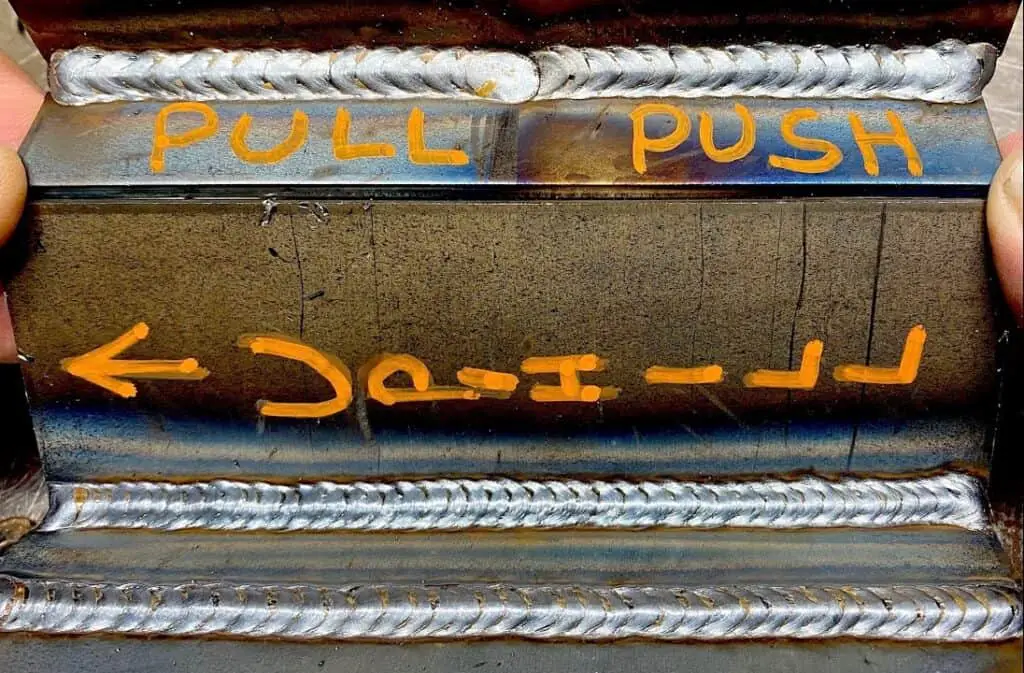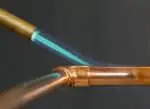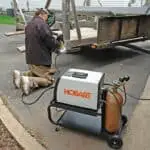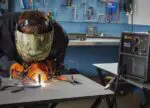MIG welding is an arc welding procedure that involves feeding a continuous solid wire electrode via a welding gun and into the weld pool to fuse the two base materials together.
However, part of the difficulty in learning how to MIG weld is that there are two particular approaches for performing the same objective.
Professional welders have argued and debated whether to push or pull in MIG welding, and which is the correct technique, since the very beginning. It’s one of those instances when there isn’t always an ultimate answer.
And talking about the push or pull technique, it is dependent on the equipment, material, method, and individual preference. Pushing a weld leads to less penetration and a more aesthetically attractive bead, whereas, pulling the weld results in a thinner, rounder bead with deeper penetration and somewhat increased weld strength.
The main objective is to obtain the greatest welds possible. What you must evaluate is what is necessary to do it.
The following elements are the factors of considerations:
→ The sort of welding equipment you’re employing, as well as the amount of efficiency it provides.
→ The amount of surface area that will be welded.
→ The weldable material (steel, aluminum, alloy), including its composition and strength.
→ The depth to which the weld must be.
→ Which welding procedure do you want to use — pulsed, droplet, or short-circuiting?
So let us delve into details about the push and pull technique.
Pulling while MIG welding- The pull technique is preferred by a number of people than the push approach. You ask why?
Well, to begin with, pulling is frequently the technique required for procedures with slag (stick). When using a push approach with these procedures, you frequently wind up running over the slag and trapping it in your puddle.
This can result in a wide range of defects. Some welders may claim that there are loopholes, but most believe that the simplest option is to just use the pull technique.
Even in operations like MIG welding that do not generate slag, a lot of people will still go for the pull technique.
The reason for this is that when you use the push method, you are primarily concerned with where you are going, but while you’re pulling, you’re mostly concerned with where you’re coming from.
You can actually see your bead as soon as it is formed which helps in monitoring progress, which saves the welders from having to redo the entire weld if they complete and find they didn’t use the proper parameters.
Advantages and disadvantages of pull technique while MIG welding
| Advantages | Disadvantages |
| A deeper penetration for a more secure connection to the base metal.
Pulls both sections of the welded foundation together for a stronger finish. |
Grinding is frequently necessary to smooth the weld.
Produces a more rounded appearance that is less visually pleasant in comparison to what a proper weld should look like. |
Pushing while MIG welding- Though pulling may result in a deeper penetration, pushing usually results in a flatter weld that reaches a larger surface area. And in some rare cases, this might result in a stronger weld than using the pull approach.
Pulling enables you to determine your bead as it is formed. It does, however, hinder your ability to see where you’re going. I mean, sure, if you’re welding a corner joint, you can see where you’re going.
But what if you’re welding an irregularly shaped piece of material that doesn’t follow a straight line.
A pull strategy will have you pausing frequently to examine where you’re going. However, the push approach enables your vision to focus on where you’re going.
Advantages and disadvantages of push technique while MIG welding
| Advantages | Disadvantages |
| A visually appealing weld.
A puddle that is level, broad, and smooth. A weld that is more tightly bonded to the base metal. |
Because the weld is not as deep, it is less robust.
Push welds frequently fail under high-stress settings, which can result in a loss of expenditure or even safety concerns, based on what you’re welding. |
When should you use the push and pull technique?
In MIG welding, there is no definitive circumstance for pulling or pushing. To select which to use or if you may use both, you must consider all the circumstances.
When to use the pull technique?
The primary reason for pulling a weld is if the resultant joint will be subjected to significant stresses. The deeper penetration achieved by tugging will strengthen the weld.
Other circumstances when you may be able to pull include:
1.) When welding straight lines and corner joints.
2.) It’s preferable to pull the weld if you’re unsure about the polarity and other parameters. This allows you to see the bead develop and alter the settings as needed, saving you time without having to repeat.
3.) When using a flux core wire in a MIG welder, always draw the weld puddle since the flux core creates slag and pushing will result in slag entrapment.
When to use the push technique?
1.) Push the weld if the connection or joint will not be subjected to high pressures and if aesthetics are more important than weld strength.
2.) When welding any irregular-shaped connection, such as one with bends and curves. You can see ahead of the bead, allowing you to correctly guide the wire along the joint.
3.) When MIG welding aluminum, always push the weld puddle such that the shielding gas completely covers the weld puddle. Due to insufficient gas coverage, pulling an aluminum weld puddle will result in a messy, porous weld.
Can you employ both the pull and push technique at the same time?
You can utilise both push and pull method together in situations such as corner joints, where you want a robust weld without sacrificing on the aesthetics.
Begin with one pulling pass for deeper penetration, followed by pushing back across for a broader, flatter, and more appealing bead.
Both pull and push technique can be used when welding a half-inch rod to a flat weld. You can begin on one side and work your way over to the opposing side, or vice versa.
Conclusion
I know you would appreciate a clear answer as to which approach is better, but the fact is that there is no such thing as a perfect method. Every circumstance is determined by the material, procedure, and equipment.
Both push and pull techniques will have similar outcomes if all other parameters stay constant.
Pulling the weld causes deeper penetration and may result in increased weld strength and pushing the weld results in a broader, better-looking weld with less penetration.
As a result, the decision to push or pull while MIG welding is influenced by two key factors- strength and aesthetics. Pull if a stronger weld is necessary, and if the joint does not require excessive strength, you can press the weld for a more visually attractive finish.







